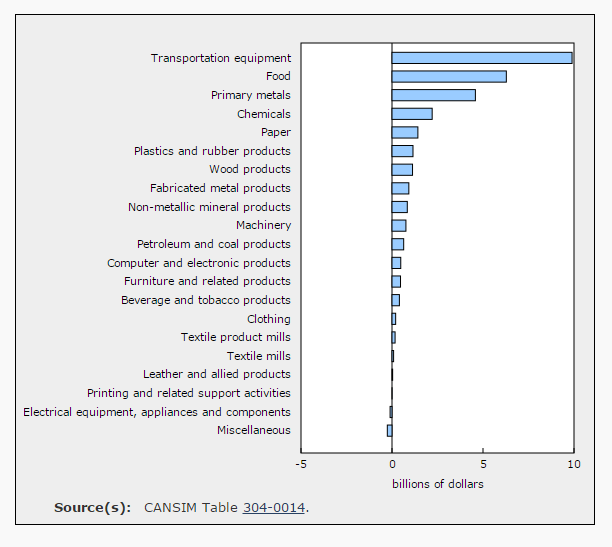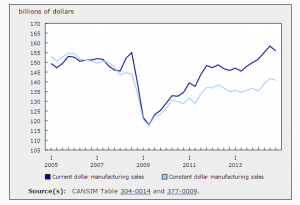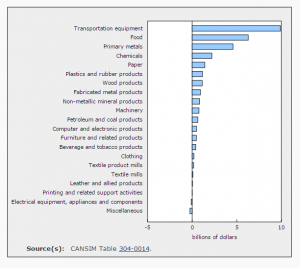
Canadian manufacturing sector reached milestone in 2014, survey shows
September 8, 2015 | By Statistics Canada


Quarterly manufacturing sales, 2005 to 2014.
Ottawa – Manufacturing sales reached an all-time high in 2014, increasing 5.3% to $621.7 billion, according to a new report from Statistics Canada: Manufacturing: The year in review, 2014. Higher sales were reported in most industries, with transportation, primary metals and food recording the largest gains. Constant dollar sales rose 2.7%, indicating a higher volume of goods sold.
Sales surpass pre-recession levels in 2014
The Canadian manufacturing sector reached a milestone in 2014 as sales surpassed their pre-recession high of $605.5 billion in 2006. Following a relatively stable period before the recession, the sector recorded significant losses during the economic downturn. Sales dropped 17.6% in 2009 as the global economy entered the recession. Manufacturing sales reached their lowest level in the second quarter of 2009. Sales rebounded in 2010 and 2011, but recovery slowed in recent years. The US manufacturing sector was quicker to rebound after the recession, with sales surpassing the pre-recession high in 2011.
Despite the current dollar gains, constant dollar manufacturing sales in 2014 remained below pre-recession levels, which peaked at $611.1 billion in 2005, indicating that higher prices were partly responsible for the growth in sales over the past few years.
Transportation equipment, food and primary metals lead sales growth in 2014
Among the 21 manufacturing industries, 19 posted higher sales in 2014. Both durable and non-durable goods contributed to the increases. Transportation equipment, food, and primary metals were mainly responsible for the overall rise, accounting for about two-thirds of the dollar gains.
Transportation equipment posts largest gains overall
Sales for the transportation equipment industry rose 9.6% in 2014, the largest increase among manufacturing industries. Motor vehicle manufacturing (+5.6%) was mainly responsible for the gain, while motor vehicle parts manufacturing was up 12.2%. Together, these two sub-industries accounted for more than half of the increase in transportation equipment. The gains partially reflected prices, which rose 4.6% for motor vehicles and 3.4% for motor vehicle parts. Sales of motor vehicles and motor vehicle parts have trended upwards in recent years; however, they remained below the pre-recession value recorded in 2007.
Aerospace products and parts also contributed to the gains in the transportation equipment industry. Aerospace production increased 13.2% in 2014, reaching its highest level since the beginning of the series. Fluctuations in the value of the Canadian currency are an important factor in measuring the value of aerospace production, as much of the economic activity in the industry is conducted in US dollars. The value of the Canadian dollar, on average, depreciated in 2014, especially in the second half of the year. As a result, the Canadian-dollar value of aerospace production increased.
Food sales lead gains among non-durable manufacturing industries
Sales of food products rose 7.1%, representing more than half of the dollar gain in non-durable industries. The increase stemmed primarily from meat product manufacturing, which rose 15.2%. Manufacturing sales of animal slaughtering (except poultry) increased 28.3%, following three years of declines. The gains in this sub-industry reflected prices, which rose 17.8% on average in 2014.

Manufacturing sales in 2014 by industry, change in billions of dollars from 2013.
In January 2014, Canada reported its first case of porcine epidemic diarrhea virus, a highly contagious pig disease. The price for pork spiked 34.5% from January to April 2014, as a result of supply concerns in the industry. Prices in the animal slaughtering (except poultry) sub-industry stayed high throughout 2014.
Primary metals advance on widespread gains
Sales of primary metals rose 10.5% to $48.0 billion in 2014, reflecting widespread increases among manufacturers in the industry. Manufacturers of iron and steel mills and ferro-alloy posted the largest gains, as sales for the sub-industry rose 26.9%, partly as a result of higher prices.
Ontario accounts for more than half of the national gain
Sales rose in seven provinces in 2014, with the largest manufacturing provinces contributing the most to the gain in dollars terms. Ontario manufacturers were responsible for over half of the national gain in dollar terms, as sales in the province rose 6.1%. While Ontario accounts for most manufacturing sales in Canada, the province has seen its share of manufacturing sales decline since the early 2000s.
Sales increased 6.4% in Quebec and 7.6% in Alberta. Meanwhile, Nova Scotia, New Brunswick, and Newfoundland and Labrador posted declines.
Transportation equipment, primary metals and food manufacturing were mainly responsible for the advance in Ontario. Transportation equipment rose 8.7%, with sales of motor vehicles and motor vehicle parts representing three-quarters of the dollar gains.
In Quebec, transportation equipment was also the main contributor to the sales growth, mainly as a result of higher production of aerospace products and parts (+14.1%). Despite the upward trend in the province, aerospace production remained slightly below its high recorded in 2008.
Annual gains in Alberta were mainly the result of a 10.8% increase in sales of petroleum and coal products. Despite the decline in petroleum prices and sales during the third and fourth quarters, petroleum and coal products posted higher sales in 2014.
The declines in Nova Scotia and New Brunswick were due to lower sales of non-durable goods. Exports of refined petroleum products declined in New Brunswick in 2014.
